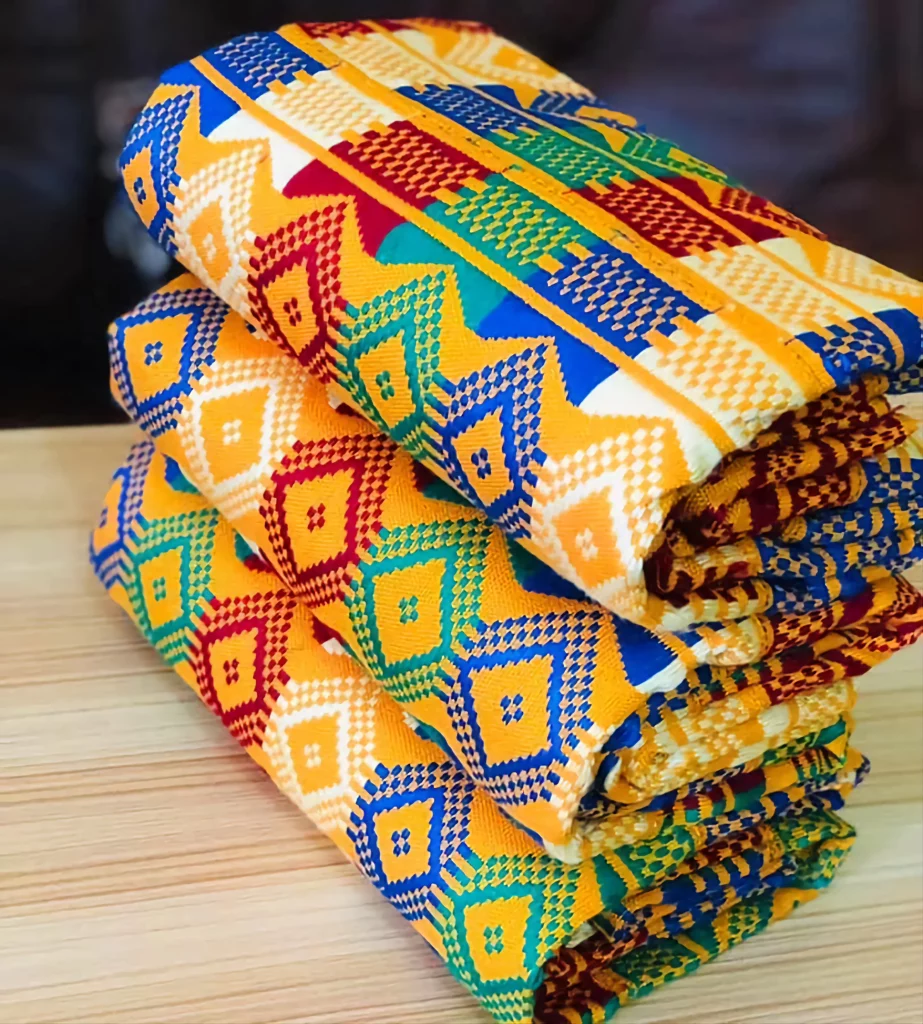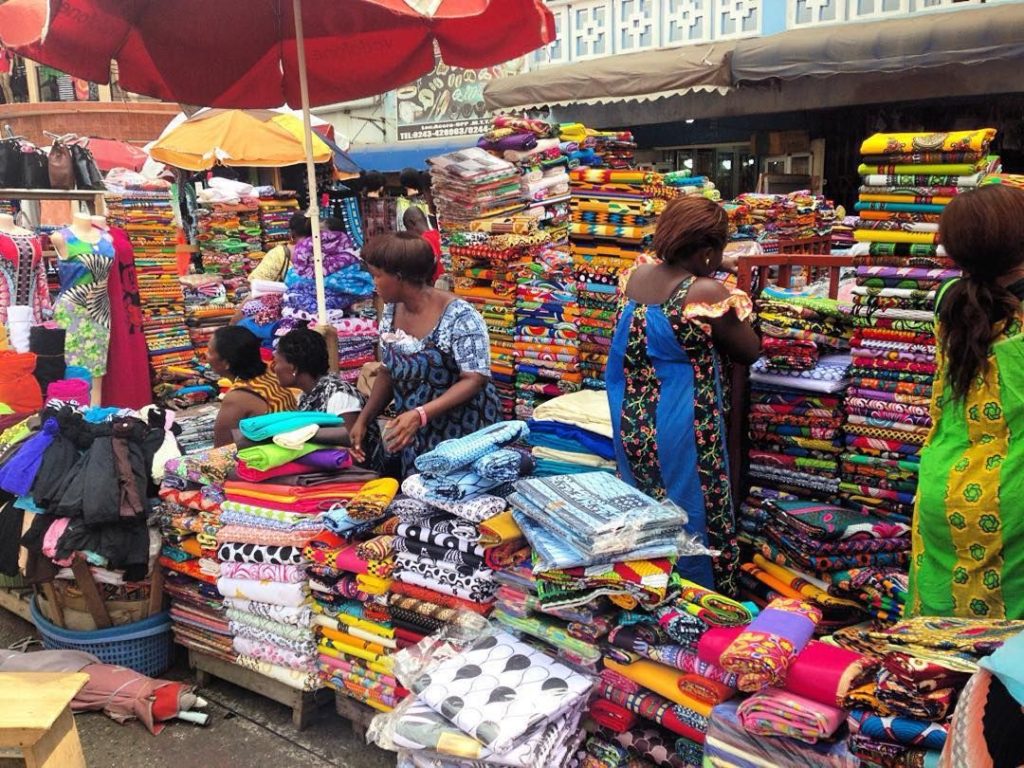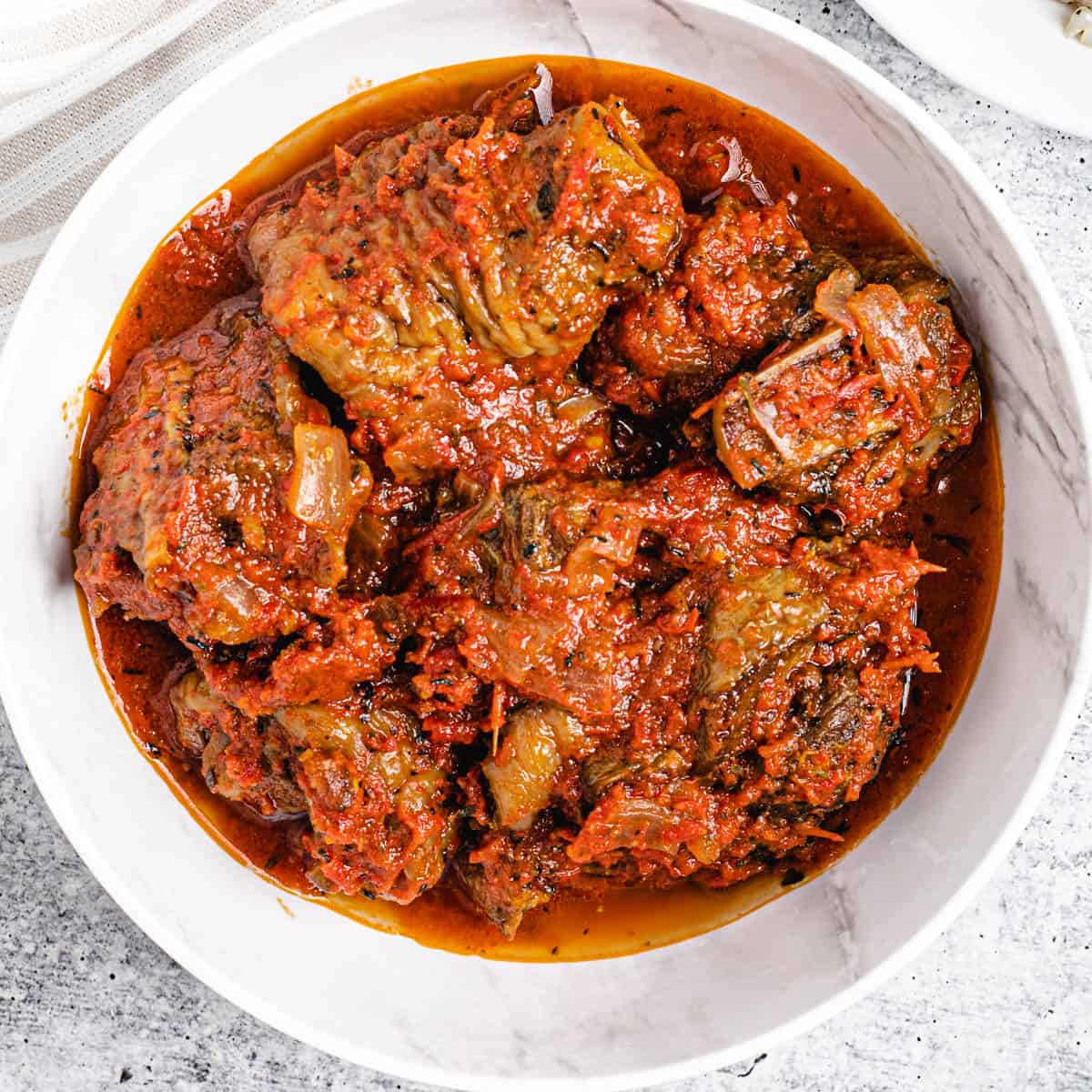Discover Ghana: Kente Cloth, Prempeh II Museum, and Makola Market
Origin:
Kente cloth, known for its vibrant colors and intricate patterns, is a traditional woven fabric indigenous to the Ashanti people of Ghana, West Africa. The word “kente” is derived from the Akan language, and it means “basket,” reflecting the cloth’s woven nature. The origins of kente are deeply rooted in Ashanti history and date back several centuries.
According to legend, the creation of kente is attributed to two Ashanti friends, Kurugu and Ameyaw, who observed a spider weaving its web. Inspired by the spider’s intricate work, the friends replicated the weaving technique using local materials such as silk and cotton. The result was the first kente cloth, celebrated for its beauty and symbolism.
Symbolism and Colors:
Kente is not merely a textile; it is a visual language that communicates cultural, social, and religious values. Each pattern and color holds significance, and the combination of these elements tells a story. Some common symbols and their meanings include:

- Nsaa (No Saah): A symbol of excellence, genuineness, and authenticity.
- Nyansapo (Wisdom Knot): Represents wisdom, intelligence, and cleverness.
- Ese Ne Tekrema (The Teeth and the Tongue): Symbolizes friendship and cooperation.
- Duafe (Wooden Comb): Stands for beauty, cleanliness, and feminine qualities.
- Funtunfunefu-Denkyemfunefu (Siamese Crocodiles): Signifies unity in diversity and cooperation.
Colors also play a crucial role:
- Red: Symbolizes passion, spiritual awareness, and bloodshed.
- Green: Represents growth, fertility, and renewal.
- Yellow: Signifies wealth, royalty, and fertility.
- Blue: Symbolizes peacefulness, harmony, and love.
- Black: Represents maturation, intensified spiritual energy, and mourning.
Weaving Process:
Creating kente is a meticulous process that requires skill and precision. The cloth is traditionally woven on narrow looms in long strips, and these strips are later sewn together to form larger pieces. The loom is operated by both men and women, each contributing to the intricate patterns.
The weaver selects specific colors and patterns based on the intended symbolism of the cloth. The weaving process involves carefully lifting and lowering different threads to create the desired design. The result is a visually stunning fabric with geometric shapes and vibrant hues.
Occasions and Significance:
Kente holds immense cultural and ceremonial importance in Ghanaian society. It is worn on various occasions, including:

- Traditional Ceremonies: Kente is an integral part of traditional rites, such as weddings, naming ceremonies, and funerals.
- Cultural Celebrations: During festivals and cultural events, people proudly wear kente to showcase their heritage.
- Academic Achievements: In many African-American communities and beyond, kente is worn during graduation ceremonies to symbolize academic success and pride in African heritage.
- Royal Ceremonies: Traditional leaders and royalty often don kente during important ceremonies and rituals.
- Religious Events: Kente is worn in some religious settings, symbolizing spirituality and connection to cultural roots.
Global Impact:
Kente has transcended its cultural origins and gained global recognition. Its bold patterns and vibrant colors have become iconic in the realm of African fashion and textiles. International designers incorporate kente into modern clothing, and its symbolic significance continues to resonate with people worldwide.
In essence, kente cloth is more than a piece of fabric; it is a living testament to the rich cultural heritage, artistry, and symbolism deeply embedded in the history of the Ashanti people and, by extension, the broader African diaspora.
Prempeh II Jubilee Museum: A Glimpse into Ghana’s Royal Heritage
The Prempeh II Jubilee Museum, located in Kumasi, Ghana, stands as a cultural gem that chronicles the rich history and royal heritage of the Ashanti Kingdom. Named in honor of Otumfuo Sir Osei Agyeman Prempeh II, the 13th Asantehene (king) of the Ashanti people, the museum offers visitors a captivating journey through time, showcasing artifacts, regalia, and historical exhibits. Let’s explore the significance and treasures held within the walls of the Prempeh II Jubilee Museum.
Preserving Ashanti Heritage:
The museum was established in 1957 to commemorate the 50th anniversary of the reign of Asantehene Prempeh II. Its primary mission is to preserve and showcase the cultural heritage of the Ashanti people, one of Ghana’s most prominent ethnic groups. The Ashanti Kingdom has a storied history, known for its rich traditions, skilled craftsmanship, and influential leaders, and the museum serves as a repository of this heritage.
Exhibits and Artifacts:
The Prempeh II Jubilee Museum boasts an extensive collection of artifacts that provides a comprehensive overview of Ashanti history, customs, and royal rituals. Some of the notable exhibits include:
- Regalia of Ashanti Kings: The museum displays the ceremonial regalia worn by Ashanti kings during significant events and rituals. Elaborate gold ornaments, royal attire, and symbolic accessories highlight the craftsmanship and artistic prowess of Ashanti artisans.
- Historical Relics: Visitors can explore historical relics, documents, and photographs that chronicle key events in the history of the Ashanti Kingdom. This includes documentation of the Ashanti-British “War of the Golden Stool” in the early 1900s, a pivotal moment in Ashanti resistance to British colonial rule.
- Traditional Art and Craft: The museum features a diverse collection of traditional Ashanti art and craft, including wood carvings, textiles, and beadwork. These artifacts showcase the creativity and cultural expression of the Ashanti people.
- Symbolism of the Golden Stool: Central to Ashanti identity is the Golden Stool, a sacred symbol of unity and kingship. The museum explores the significance of the Golden Stool and its role in Ashanti governance and spirituality.
Architecture and Location:
The Prempeh II Jubilee Museum is housed in a building that reflects traditional Ashanti architectural elements. The design incorporates elements such as adinkra symbols and decorative carvings, creating a visually striking structure that complements the cultural significance of its contents. The museum’s location in Kumasi, the cultural capital of Ghana, adds to its accessibility and prominence as a cultural institution.

Educational and Cultural Impact:
The museum serves as an educational hub, offering insights into the history, customs, and cultural practices of the Ashanti people. School groups, scholars, and tourists alike visit the Prempeh II Jubilee Museum to deepen their understanding of Ghana’s cultural heritage. The preservation of Ashanti traditions through the museum contributes to cultural continuity and fosters a sense of pride and identity among the Ashanti people.
Tips for Visitors:
- Guided Tours: Consider taking a guided tour to gain a more in-depth understanding of the exhibits and their cultural significance. Knowledgeable guides can provide valuable insights.
- Respectful Photography: While photography is often allowed, be mindful of the museum’s policies and avoid photographing sacred or sensitive artifacts without permission.
- Plan Ahead: Check the museum’s operating hours and any special events or exhibits before planning your visit. This ensures that you make the most of your experience.
- Learn About Ashanti History: Familiarize yourself with key aspects of Ashanti history before visiting to enhance your appreciation of the exhibits.
The Prempeh II Jubilee Museum stands as a testament to the resilience, traditions, and cultural legacy of the Ashanti Kingdom. It invites visitors to embark on a fascinating journey through Ghana’s past, offering a glimpse into the royal heritage that continues to shape the identity of the Ashanti people.
Makola Market: The Largest and most Diverse Commercial Hub in Accra Ghana
Makola Market, situated in the heart of Accra, Ghana, is a bustling and vibrant marketplace that stands as a testament to the energy and diversity of the country’s capital. With its labyrinthine alleys, colorful stalls, and a kaleidoscope of goods, Makola Market is not just a commercial hub; it’s a cultural experience. Let’s delve into the sights, sounds, and significance of this iconic market.
A Tapestry of Commerce:
Makola Market is a sprawling marketplace where commerce thrives in its most dynamic and unfiltered form. The market is a mosaic of stalls and shops, each offering an array of products ranging from fresh produce and textiles to household goods and traditional crafts. The sheer variety and intensity of activity make Makola Market a microcosm of Accra’s economic vibrancy.
Fresh Produce and Foodstuff:
One of the defining features of Makola Market is its extensive selection of fresh produce and food items. Vendors proudly display fruits, vegetables, spices, and other culinary delights, creating a sensory feast for visitors. The market plays a crucial role in the local food supply chain, connecting farmers and producers with the diverse population of Accra.
Textiles and Fashion:
Makola Market is renowned for its vibrant textile section, where bolts of colorful fabric are on display, creating a visual spectacle. Fabrics of various patterns and textures are available, reflecting the rich tradition of Ghanaian textiles. Visitors can explore this section to purchase unique materials for traditional clothing, modern fashion, or vibrant accessories.

Crafts and Artisanal Goods:
Artisans and craft vendors contribute to the market’s cultural richness by showcasing traditional Ghanaian craftsmanship. Handwoven baskets, beadwork, carvings, and traditional artifacts are among the many offerings. Makola Market provides a platform for local artisans to share their talents and heritage with a broader audience.
Navigating the Labyrinth:
Makola Market is known for its intricate layout, with narrow pathways winding through clusters of stalls. Navigating the market is an adventure in itself, with surprises at every turn. While it may seem chaotic to the uninitiated, the layout has an inherent logic, and each section specializes in specific goods, ensuring a diverse and well-organized shopping experience.
Cultural Significance:
Beyond its commercial function, Makola Market is a cultural landmark that encapsulates the spirit of Accra. It is a meeting point for people from various backgrounds, fostering social interactions and community engagement. The market is a reflection of Ghana’s cultural diversity, bringing together different ethnicities, languages, and traditions in a shared space.
Preserving Tradition in a Modern City:
In the midst of Accra’s modernization, Makola Market stands as a resilient symbol of tradition and continuity. The market has adapted to changing times while retaining its essential character. While modern supermarkets and malls have emerged in Accra, Makola Market remains an essential destination, offering an authentic and irreplaceable experience for both locals and tourists.

Tips for Visitors:
- Embrace the Experience: Allow yourself to immerse in the vibrant atmosphere, engage with vendors, and savor the diversity of products.
- Bargain with Respect: Haggling is a common practice, but it’s essential to do so respectfully. It’s part of the market culture, and both buyers and sellers often enjoy the negotiation process.
- Watch Your Belongings: As with any bustling market, it’s advisable to keep a close eye on your belongings to ensure a smooth and enjoyable visit.
- Try Local Delicacies: Explore the food stalls to sample local delicacies and snacks. It’s an excellent opportunity to experience Ghanaian flavors.
Makola Market stands not just as a commercial center but as a living testament to the spirit, resilience, and cultural richness of Accra. Visiting this iconic market is an invitation to witness the heartbeat of the city and connect with the pulse of daily life in Ghana’s capital.
Related Reading Discover Ghana: 10 Must-Visit Places, Surprising Accra Facts, and Ashanti Kingdom Exploration

